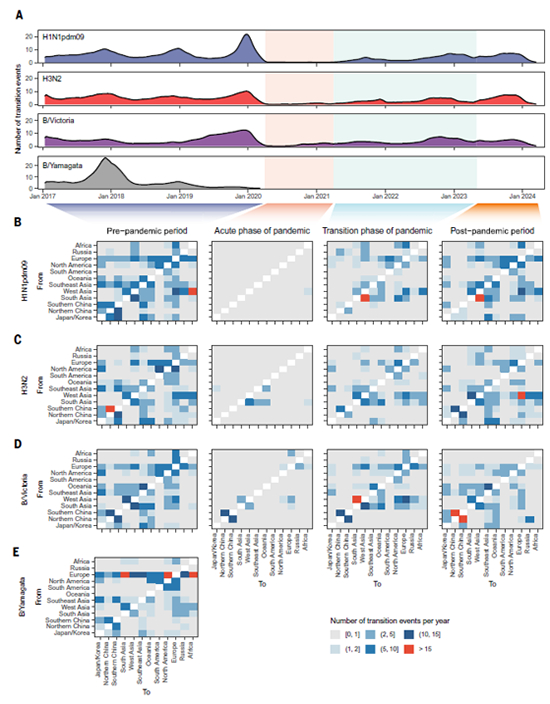

Changes in transmission patterns of seasonal influenza viruses before,
during, and after the COVID-19 pandemic
With the support of National Natural Science Foundation of China projects
(approval numbers: 82130093, 82073613, 823B2089), Professor Yu Hongjie's team
from Fudan University, together with Professor Moritz Kraemer from Oxford
University, Professor Philippe Lemey from the University of Leuven in Belgium,
and Professor Oliver Pybus from the Royal Veterinary College, has made progress
in the study of the global transmission dynamics of seasonal influenza viruses.
The related achievements, titled "COVID-19 pandemic interventions reshape the
global dispersion of seasonal influenza viruses", were published online in the
journal Science on November 8, 2024. Paper link:
https://www.science.org/doi/10.1126/science.adq3003 .
Influenza virus has characteristics such as antigenic variability and host
ecological diversity, which can cause periodic global pandemics and threaten
human health. Studying the global transmission patterns of influenza viruses is
of great scientific significance for developing influenza prevention and control
measures. The non pharmacological interventions implemented during the COVID-19
pandemic have broken the "norm" of seasonal influenza virus transmission, but
the scientific community has not yet revealed how changes in human behavior
disrupt the global transmission patterns of influenza viruses.
The research team integrated global influenza virus epidemiological
monitoring data, genetic sequence data, and population air traffic data,
dividing the world into 12 regions. Within the framework of Bayesian system
dynamics, they reconstructed the seasonal influenza virus transmission patterns
for four periods and estimated the relevant parameters and potential driving
factors of transmission. The research results found that the activity level of
seasonal influenza viruses and inter regional air traffic have undergone a
process of "decline followed by recovery". Further combining gene sequence data
within the framework of a system dynamics model with temporal heterogeneity, it
was found that inter regional air traffic (representing long-distance population
movement) is the main driving factor for global seasonal influenza virus
transmission in four periods. By estimating the main regions in the geographic
evolutionary tree, it was found that during the COVID-19 pandemic, South Asia
and West Asia were key regions for maintaining the circulation of influenza A
and B/Victoria viruses, respectively. To evaluate the similarity in transmission
intensity and patterns among different influenza seasons during the pandemic,
the team further utilized multidimensional scaling analysis to study the
recovery of seasonal influenza virus transmission. It was found that in the
later stage of the COVID-19 pandemic (May 2023 March 2024), the pattern and
intensity of global seasonal influenza virus transmission have basically
returned to pre pandemic levels (Figure).
The research team used the influenza A H3N2 virus as an example to estimate
the circulation persistence of strains in Africa, Southeast Asia, and South
Asia, and found that it significantly increased during the COVID-19 pandemic,
suggesting relatively independent evolution and circulation. By constructing a
hierarchical Bayesian regression model, it was found that antigen drift and
inter regional population movement are significantly correlated with the
increase in circulation persistence during the COVID-19 pandemic. Finally, the
genetic diversity and selection pressure of each seasonal influenza virus in
recent years were evaluated, and the potential reasons for the disappearance of
the B/Yamagata lineage were explored.
This study identified the epidemic characteristics and key transmission
regions of seasonal influenza viruses worldwide, clarified the impact of non
pharmacological interventions to address COVID-19 on the evolution/circulation
independence of regional influenza viruses, the robust recovery of influenza
virus transmission patterns after the COVID-19 pandemic, and the uncertainty of
the origin of new influenza strains. It emphasized the importance of
strengthening virological and genetic monitoring of respiratory pathogens,
adjusting vaccination strategies and monitoring directions in a timely manner,
and providing empirical evidence for future comprehensive responses to influenza
pandemics.